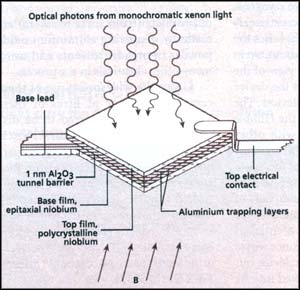Gazing clearly
 optical astronomy has come a long way since the time of Galileo. From the crude telescopes used to observe the moons of Jupiter, to the large self-correcting mirrors in the latest generation of optical telescopes, the range of instruments available to today's astronomer is astonishing. There is however the persistent problem of getting the maximum information about the object from the small amount of light (a relatively small number of photons) that is received into the telescope. The idea is to get information about the number of photons, their energy, polarisation and time of arrival at the telescope. At the moment, even with the remarkable development in instrumentation available for astronomy, several different instruments have to be used for this purpose, thereby decreasing the efficiency of the detector. But now, with the work of A Peacock and his team, the goal of having a single detector perform several of these measurements with reliability has almost been reached.
optical astronomy has come a long way since the time of Galileo. From the crude telescopes used to observe the moons of Jupiter, to the large self-correcting mirrors in the latest generation of optical telescopes, the range of instruments available to today's astronomer is astonishing. There is however the persistent problem of getting the maximum information about the object from the small amount of light (a relatively small number of photons) that is received into the telescope. The idea is to get information about the number of photons, their energy, polarisation and time of arrival at the telescope. At the moment, even with the remarkable development in instrumentation available for astronomy, several different instruments have to be used for this purpose, thereby decreasing the efficiency of the detector. But now, with the work of A Peacock and his team, the goal of having a single detector perform several of these measurements with reliability has almost been reached.
The workhorse of optical astronomy at the moment is a charge-coupled device (ccd). This is basically a charge transfer semiconductor device in which discrete packets of charge are transferred from one point to another. It consists of an array of semiconductor capacitors, which become charged when a photon deposits its energy on to it. The charge pattern on the ccd can be used to gather reliable information about the impinging photon.
The advantage of a ccd is that it has a linear response and is very efficient at some wavelengths. However, it has been well known that ccds are inefficient at lower wavelengths and lack time resolution, that is, information regarding the time of arrival of the photon. Their wavelength resolution is also not very good. Astronomers usually make up for these shortcomings by using filters and having short exposures, thus limiting the use of ccds to special sources.
Peacock and his colleagues have developed a device that overcomes some of the limitations of a ccd and which has a high performance when compared to the existing systems. The device is a niobium-based superconducting tunnel junction (stj). These devices have been extensively used in the x-ray region for photon detection. The stj used by Peacock and his group has been specifically designed for use in the optical region and is extremely sensitive to single photons. It consists of a sandwich of niobium, aluminium, aluminium oxide, aluminium and niobium multilayer deposited on a polished sapphire. The two niobium layers are 100 nanometres (one nanometre = 10-9m) thick while the aluminium films are 120 nanometres thick. The photon is absorbed in the top niobium layer and a series of processes result in the photon energy going to charge carriers (broken Cooper pairs as opposed to free electrons) in the device. The device is more sensitive to photons because as opposed to a ccd where a single photon releases only one electron, in niobium about 1,000 electrons are released per photon. By measuring the charge, detailed information regarding the photon can be obtained. The device has an efficiency of about 50 per cent, which is comparable to the ccd devices available. The wavelength resolution is still not very good (about 45 nanometres) but work is going on to make stjs with superconducting materials other than niobium. This may increase the resolution as has been demonstrated with the use of a tantalum-based stj (Nature , Vol 381, 1996).
The use of a superconducting device, however, has its own limitations; the device has to operate at an extremely low temperature, below
